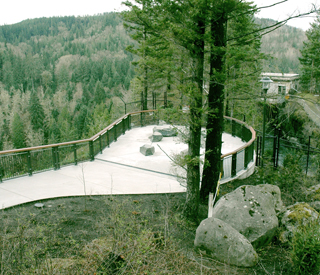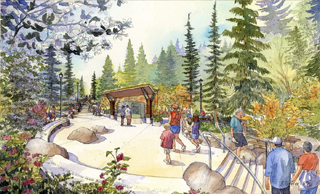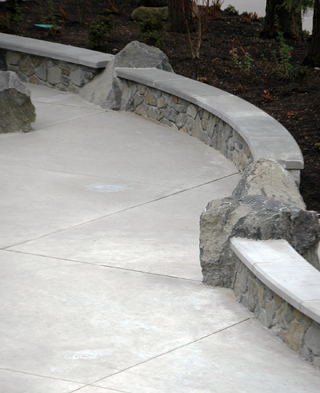|
Subscribe / Renew |
|
|
Contact Us |
|
| ► Subscribe to our Free Weekly Newsletter | |
| home | Welcome, sign in or click here to subscribe. | login |
Environment
| |
 |
March 25, 2010
Snoqualmie Falls park ready for the next generation
Design + Planning at Aecom
Snoqualmie Falls is a setting of natural beauty and raw, majestic power. Dropping 268 vertical feet over volcanic rock, the falls send a thundering pulse of mist back up the canyon walls and into the fir-covered hills.
Visitors come to view this spectacle from the Upper Park area located atop a cliff adjacent to the falls. One of the most popular regional recreation destinations in Washington state, the falls attracts up to 2 million visitors per year to this natural, recreational, cultural and historic treasure. The resulting wear-and-tear was beginning to show.
The Design + Planning practice at Aecom in Seattle provided landscape architectural services for needed improvements at the Upper Park. Final construction to improve access and visitor circulation, enhance viewing opportunities and interpretive experiences, and improve habitat will be complete in May. Remaining elements to be installed include a green roof kiosk, wayfinding bollards and interpretive signs.
A master plan developed by Aecom in 2006 provided a guide for recreation and habitat improvements for all recreation areas at Snoqualmie Falls, including the Upper Park, trail to the Lower Park, Lower Park, and Plant 1 Historic Area. Implementation of the master plan began with improvements to the Upper Park area. The importance of the park as a natural jewel and an oasis in the surrounding urbanizing environment became evident during this process and guided the design.
The parks are within a hydroelectric generation facility owned and operated by Puget Sound Energy. To get its federal operating license renewed, PSE agreed to upgrade the recreation areas within the facility. This spring, PSE is beginning a project to replace and upgrade the hydroelectric facilities at Snoqualmie Falls, allowing for additional park improvements to be made in the other recreation areas during the four-year construction period.
Upper Park vision
Aecom's vision for the Upper Park was to create a place that celebrates the magnificent views and improves the experience of exploring the site. The improvements were designed to protect and enhance the natural landscape while respecting the cultural significance of the site.
The dramatic landscape inspired a simple, yet robust aesthetic for the park and materials used. This is consistent with a “national park-like setting” that is rustic yet refined, while robust enough to withstand millions of visitors over the next several decades.
Use of the park continues to be focused on viewing the falls. Trails and pathways connect users to significant viewing areas and interpretive nodes within the park. The park itself will become the nexus of several regional and community trails.
Elements within the park reveal layers of natural, cultural, historical and operational complexity associated with the site. The visitor experience is more personal than social. There is less opportunity for large gatherings and activities such as picnicking, with the emphasis instead on trails and connecting interpretive elements.
Through careful site design, appropriate material choices, revegetation of the native landscape, and the introduction of interpretive signage, the overall vision for the Upper Park was accomplished.
Improvements
The Upper Park has evolved over the past several decades, reacting to ever-growing public interest. Pathways were widened in a patchwork approach as desired paths became obvious through use. Most pathways were constructed with varying types of surfaces and some that were once accessible no longer met current code. Various chain-link guardrails and fencing were added to control access and for safety.
Interpretation of the area was non-existent. Few know that hydroelectric energy has been produced at the falls since 1898 or that the Snoqualmie Tribe's creation story originates at the falls.
An under-used, low-roofed picnic shelter adjacent to the main parking lot was removed and an open-air interpretive plaza was carefully located amongst towering conifers. The new plaza is ringed with mortared basalt stone seat walls and large boulders, giving a sense of having existed longer than a few months.
The plaza will be a gathering place, or “eddy,” for visitors before they migrate to one of the three viewing areas of the falls. These viewing areas — the Rim Viewpoint, Falls Viewpoint and Peregrine Viewpoint — all provide different vantage points and interpretive experiences from the top of the cliff.
A series of wide “cascading” stairs, lined with basalt boulders, lead from the new plaza to the Rim Viewpoint and nearby pedestrian bridge crossing Highway 202. Stainless steel word inlays — such as “rumbling,” “plunging” and “soaking” — cascade down the step surfaces.
A new accessible ramp, much of it sloped gently enough to avoid handrails, zigzags on the hill with these stairs through a dense planting of native sword ferns, currant, vine maples and dogwoods.
Rhododendrons and azaleas are sprinkled throughout this new landscape for color and as a reminder of the previous landscape. Mature vegetation, including large cedars and firs, was preserved by carefully placing new walkways and utilities. Crisscrossed underneath the park and out of site are new sewer, water and electrical lines to service restrooms, irrigation and lighting needs.
| Landscape Northwest Advertisers |
|
Nakano Associates LLC (www.nakanoassociates.com) Pacific Earth Works, Inc. Kim Newsome (www.pacificearthworks.com) Raedeke Associates, Inc. (www.raedeke.com) 2010 U.S. Senior Open (www.2010ussenioropen.com)
|
A major element within the Upper Park is more than 1,000 linear feet of new guardrail to protect visitors from the extreme drop to the plunge pool below. Vertical pickets of thin welded steel, painted the gray-brown color of the cliff rock beyond, help this element blend in to emphasize the views beyond. A thick ipe wood cap on top of the guardrail gives visitors a place to comfortably lean and take in the view.
Before, the Peregrine Viewpoint was a skinny sidewalk ending at a chain-link fence covered in ivy. Now a large bulbed plaza, punctuated by boulders and rimmed with the custom guardrail, provides spectacular views of the falls and peregrine falcons nesting on the cliff across the river. Visitors can now stand on boulders, instead of garbage cans, to get optimal photos of the falls.
Local basalt was used for all of the large boulders that accent the site and for the custom stone seat walls around the new plaza. A cedar split-rail fence was used to define the edge of a walkway. Rails and guardrails were painted to match the stone in the surrounding landscape. The subtle color yet large and robust nature of these elements creates a familiar national park-like feel and a memorable Snoqualmie Falls experience.
Jeff Bouma, ASLA, is a landscape architect in the Seattle offices of Design + Planning at Aecom. Bouma has been with Aecom (formerly EDAW) for nine years and has been the designer and project manager for several built projects in the Northwest.
Other Stories:





